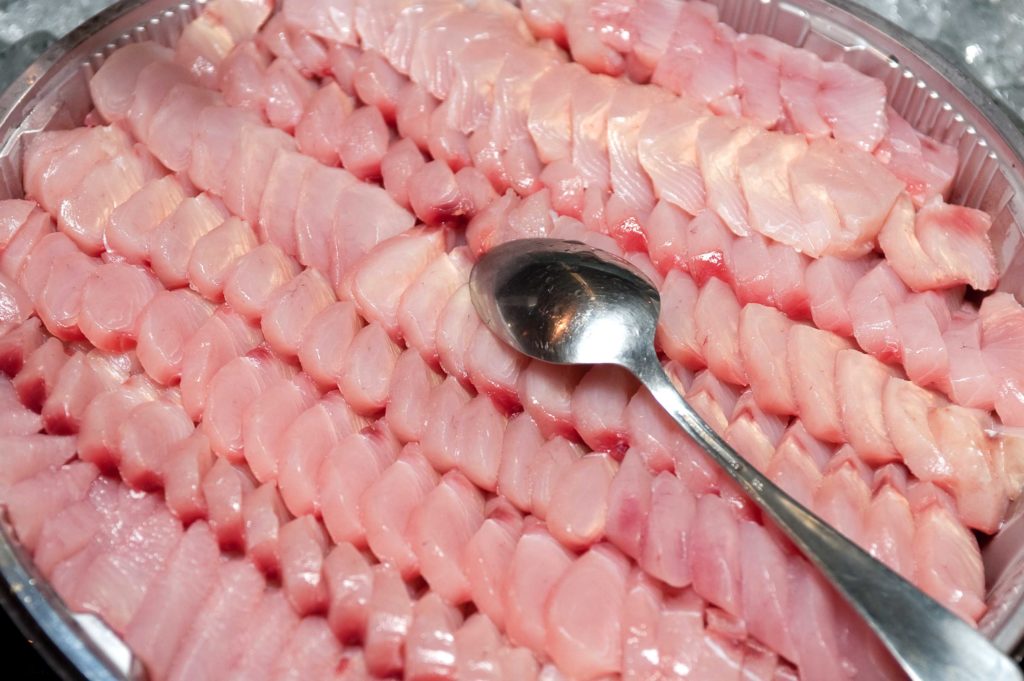Sashimi: Raw Fish with Wasabi

Description
Fresh seafood that is sliced and eaten with a soy sauce and spicy Japanese horseradish (wasabi) dipping sauce.
History
Origin
As with many Pacific island societies, fish is a staple in the diet of the indigenous inhabitants of Guam. The ocean served as a natural resource and provided an array of seafood including fish, shrimp, and a variety of shellfish. An account written by Catholic missionary Fray Antonio del los Angeles during the 16th century notes that the CHamorus ate raw and ungutted fish.
Other reports state that fish was eaten for lunch (na’talo’åne) and dinner (sena), cooked or raw. Fish was also salted, dried or placed in brine for preservation to be eaten later. In terms of preparation, the early CHamoru combined fresh fish with lemon, salt, and grated coconut. The method of preparation is very similar to present-day version of fish kelaguen. Mussels were also eaten raw and prepared in a similar fashion with grated coconut, lemon, and pepper (donne’).
Japanese first came to the Mariana Islands as sailors and merchants, and eventually began settling in the islands. Sashimi is a Japanese dish that consists of fresh raw seafood that is dipped in a soy sauce and wasabi sauce. The adoption of Japanese cuisine in Micronesia incorporated sashimi, steamed rice, soy sauce, Japanese noodles, miso soup, sukiyaki, and sweet rice cakes into the CHamoru diet.
Evolution
As noted above, the notion of eating raw fish was not a foreign one to the CHamorus. However, the introduction of horseradish, an extremely pungent and spicy flavor, changed this dish significantly. For preparation of this dish, the Japanese horseradish is grated then mixed with the soy sauce. Prepared wasabi is now sold in tubes and readily available in most grocery stores in addition to the powdered form that has to be mixed with water before serving. Many CHamorus deviate from the standard Japanese mixture of soy sauce and wasabi and add lemon to the dipping sauce.
Preparation
Men and women can prepare this dish, but it’s preparation is more commonly done by men.
As sashimi is a general term to indicate raw seafood with the dipping sauce, just about any seafood could be considered for sashimi as long as it is fresh and sliced approximately ½” thick or cut into bite-sized pieces. The most popular fish for this dish, due to its affordability and availability, is tuna; particularly yellow-fin tuna.
For the sauce, one should be careful when mixing the soy sauce and wasabi as it is an extremely strong spice. Add the wasabi to the soy sauce sparingly in increments until you reach just the right amount of heat for your palate.
Placement on table
Sashimi, along with a dish of wasabi-soy sauce dipping sauce, is placed near other seafood dishes next to the kelaguen section of the fiesta table. Kelaguen is set after the meat selection (totche) that is second to the starch section (åggon) at the head of the table. In large parties, seafood dishes and kelaguen dishes are placed on a separate table.
Recipe
Sashimi: Raw Fish with Wasabi
- 1 pound yellow fin tuna fillet
- 1 tube prepared wasabi, or powdered form
- ½ – 1 cup soy sauce, according to taste
- 1 lemon, optional
Cut fish into approximately ½” thick slices. Mix ¼ teaspoon wasabi paste (or as much as desired) with soy sauce, add lemon. If the powdered form of wasabi is used dilute with a sparing amount of water. Add soy sauce. Serve.